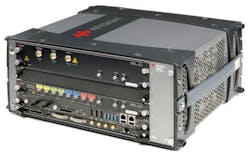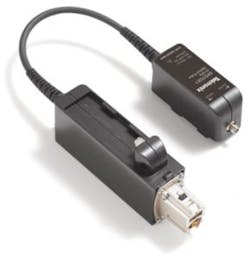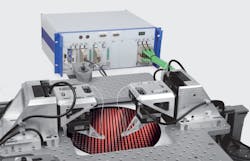Optical communications technology is seeing innovation on many fronts—from opto-electronic devices to cloud infrastructure. Companies are addressing the technology in areas ranging from test equipment to optical components and interconnects as they push to move the industry forward.
“This industry is in a continuous race to enable the transmission bandwidths required to serve the growing bandwidth demand of mobile video and other rich-media services, traffic increases driven by the data centers, and cloud-based services offered by web-scale corporations,” said Dr. Joachim Peerlings, VP and GM of Networks and Data Centers at Keysight Technologies. “This applies to connections between servers and switches inside datacenters to the same degree as to datacenter interconnects and transport networks. Every connection type and modulation format has its own sweet spot in terms of bandwidth, latency, achievable distance, power consumption, cooling, and cost.”
When asked what applications Keysight Technologies addresses—for example, datacenters, 5G-related networks, photonic integrated circuits and electro-optical devices, SDN, or cloud deployments—Peerlings replied, “All the above.” He added that Keysight also offers solutions along the entire value chain for these market segments—from component development to network equipment, with the company addressing the latest technologies including silicon photonics, 400G PAMx, and coherent transmission. He said that while the company offers a broad product portfolio for the photonic industry, it also strives to offer customers solutions that allow a large degree of configurability.
He said Keysight helps customers validate and optimize their designs with respect to their chosen optimization criteria, explaining that the company works with industry leaders, standardization bodies, and industry consortia. “In rollout and manufacturing, we help our customers improve yield and test throughout with solutions that are tightly specified and offer short measurement cycles.”
As an example of Keysight’s relevant offerings, he cited the N4391A optical modulation analyzer, a real-time-scope-based test solution for 600G and Terabit transmission that addresses the needs of researchers and designers of coherent transmission systems. “By continuous improvements of its bandwidth, we’ve enabled our customers to evolve their coherent optical transmission technology from the first 100G approaches through 600G-capable links—and now they are shooting for the Terabit.”
To address the needs of manufacturers of 400G coherent transmission gear, he said, “We’ve just introduced the M8290A modular optical modulation analyzer and high-speed digital test solution. Hosted in an AXIe chassis, this solution (Figure 1) is highly configurable, compact, and attractively priced. Based on this hardware, we offer two turnkey solutions that let customers jumpstart their final testing—one for integrated coherent receiver testing, and a more multipurpose solution for the test of coherent optical transmit-and-receive devices.”
Courtesy of Keysight Technologies
He cited the M8290A as an example of the degree of configurability Keysight provides, explaining that the instrument offers stimulus-response test of coherent optical transmit and receive devices with one single control software tool. “To save operator time, all tests are performed with the same connection to reduce uncertainty and increase repeatability of measurement results,” he said. “De-embedding of cables and fixtures improves measurement accuracy and contributes to better test margins. Our waveform generator—an AXIe blade just like the modulation analyzer and the digitizer in the M8290A—ensures the highest flexibility of signal formats on the stimulus side. All that is possible because we can pick from a rich portfolio, and we know each solution element inside-out.”
Real-time and sampling
One focus of Tektronix is on the R&D and manufacturing markets for optical and electrical networking, according to David Njuguna, technical marketing manager at the company. “Tektronix has recently introduced new optical test solutions that leverage both the real-time and sampling platforms, enabling our customers with the right solution at the right time within their test workflow,” he said.
One such solution, introduced last September, is the DPO7OE1 calibrated optical probe (Figure 2) and analysis software for use with real-time oscilloscopes. It is optical reference receiver (ORR) compliant for 28-Gbaud PAM4 applications and supports IEEE/OIF-CEI standard-specific measurements. It complements Tektronix’s optical PAM4 analysis tools for sampling oscilloscopes, giving design teams efficient test solutions for all stages of the optical transmitter workflow.
Courtesy of Tektronix
Based on real-time oscilloscopes like the DPO70000SX, the new offering allows R&D and system engineers to more easily troubleshoot their optical devices by adding debug capabilities, including software clock recovery for PAM4 and NRZ, triggering, and error detection.
Tektronix said one company that understands the value of an optical PAM4 solution based on real-time oscilloscopes is Maxim Integrated, a manufacturer of high-speed, low-power optical communications devices for datacenter applications.
“Advanced optical modulation formats like PAM4 require system testing with both sampling and real-time oscilloscopes,” said Jan Filip, director of advanced R&D at Maxim Integrated, in a press release. “The new real-time oscilloscope-based solution allows us to provide critical debugging feedback to the development teams and to emulate advanced optical receiver systems using offline Matlab algorithms. Tektronix offers the best performing real-time oscilloscope detection solution to our optical and PAM4 test requirements and is our strategic partner for advanced measurement platforms.”
The DPO7OE1 offers 33-GHz optical bandwidth for 28-Gbaud PAM4 debug applications. It can also be used for legacy NRZ applications. Analysis packages support standard optical measurements including ER, AOP, OMA, eye height, and eye width as well as PAM4 IEEE and OIF-CEI standard-specific measurements, including TDECQ (Transmitter and Dispersion Eye Closure Quaternary).
Optical power meters
OptoTest Corp. has been focusing on optical power meters. In September, the company introduced the new OP740, its latest advancement in multichannel high-speed optical power meters, which debuted in September at ECOC in Rome, Italy. The unit offers sampling rates of up to 10,000 samples per second and is available with up to 24 channels per unit. The OP740 retains many of the existing specifications of the current OP710 optical power meter, while introducing features such as variable sampling rate, simultaneous multichannel display, and a more robust user interface.
The full-color touchscreen display allows the user to view multiple channels of power readings at the same time without using software and simplifies test procedures through the front panel. Variable sampling rates will allow operators to adjust sampling speed of the unit to match the needs of their tests.
Another new feature of the OP740 is the inclusion of a USB 3.1 port to support the increased sampling rates. A USB 2.0 port will be available on all OP740s for backwards compatibility and integration into existing systems.
And in January, OptoTest announced a new update to the OP1021 launch condition analyzer software that allows for mode field diameter (MFD) measurement per TIA/EIA-455-191A and IEC 60793-1-45. The update to the software package used with the OP1021, OPL-LCA, takes advantage of the unit’s existing capabilities to perform the MFD measurement using the direct farfield measurement technique. The direct farfield method is regarded as the reference test method for determining the mode field diameter of single mode fiber. This measurement is instrumental in the development and qualification of single-mode fiber, making the OP1021 suitable for any fiber production environment.
For its part, EXFO Inc. has released what the company calls the industry’s first “PON-aware” passive optical network (PON) power meter for testing next-generation and legacy PON technologies. The PPM-350D PON power meter automatically detects and adapts test parameters for the PON technology in use at the customer premises. These new capabilities eliminate costly guesswork by field technicians during the critical service-activation phase.
Each home, school, business, or other CSP customer has different requirements for the upstream and downstream speeds of broadband delivered over fiber, ranging from basic to ultra-fast, the company says. To provide the right speeds to the right customers, CSPs are deploying multiple PON technologies by overlaying multiple new wavelengths on existing fibers.
“With next-gen PON upgrades underway in every region, seamless upgrades require the overlaying of new wavelengths on existing fibers as operators combine existing PON with next-gen PON solutions,” said Julie Kunstler, principal analyst, Ovum’s Next-Gen Infrastructure Practice, in a press release. “EXFO’s PON meter enables technicians to accurately test, and thereby fix, any customer connections during service activation for legacy and next-gen PON technologies such as GPON, EPON, XG-PON1, XGS-PON, 10G-EPON and NG-PON2, without needing to know an operator’s specific upgrade roadmap.”
“We developed the PON-aware power meter to tackle two key challenges for CSPs dealing with multiple legacy and next-gen technologies,” added Stéphane Chabot, EXFO’s vice president, test and measurement. “First, field technicians can’t fix problems that older power meters can’t see. Second, it can be difficult to select the right test parameters for the technology, which increases the risk of meaningless test results and false positives. By using automation to solve both problems, the PPM-350D helps CSPs avoid the high costs of sending tech teams back to fix problems for frustrated new customers.”
The PPM-350D PON power meter is compatible with GPON, EPON, 10G-capable, and NG-PON2 networks as well as RFoG.
In addition, EXFO has unveiled SkyRAN, a scalable remote access and monitoring solution for fiber-based fronthaul networks (Figure 3). Developed in collaboration with the largest wireless carriers in North America, SkyRAN provides real-time, on-demand testing and 24/7 monitoring of fiber-optic networks and spectrum. The SkyRAN solution was showcased in January at the 2018 Verizon Technology Users Forum (VZTUF-XII) in Austin, TX.
Courtesy of EXFO
SkyRAN combines the industry’s highest resolution RF spectrum analysis over CPRI with the most advanced fiber monitoring capabilities on the market, the company says, adding that SkyRAN reveals RF issues that were previously either undetectable or difficult to identify, thereby enabling mobile network operators (MNOs) to proactively identify and resolve RF interference, PIM, and fiber-related issues before they could impact subscribers.
And in other optical communications news, in October, Fiber Optic Center Inc., an international distributor specializing in cable assemblies, announced it is offering the Viavi FiberChek Sidewinder, a handheld inspection and analysis solution for multifiber connectors.
The FiberChek Sidewinder is an all-in-one handheld inspection and analysis solution for multifiber connectors such as MPO (multifiber push-on) or other multifiber connectors. The company reports that with contaminated connectors the primary cause for troubleshooting in optical networks, the IEC has released IEC 61300-3-35, a global standard that establishes acceptance criteria for the quality and cleanliness of the fiber connector end face. This standard has been widely adopted and has also been incorporated into other standards, including both TIA-568.3 and ISO/IEC 11801.
The company further says that the FiberChek Sidewinder addresses the challenge in MPO inspection with the ability to test to industry standards with the push of a button, automate inspection, locate and identify defects and scratches, identify inspection-zone locations, and integrate results into certification reports.
Exhibits at OFC
The companies mentioned thus far in this article are expected to be among more than 700 exhibitors at the Optical Fiber Communication Conference and Exhibition (OFC) to be held March 11-15 in San Diego.
“OFC is an important event for Keysight to meet customers and present our portfolio of test solutions within the photonic industry,” said Peerlings. “At OFC 2018, Keysight will demonstrate test solutions for 100G, 400G, 600G, and 1-Tb/s transmission—that includes both coherent signal forms such as QAM64 and noncoherent signal forms such as PAM4. We will showcase our latest optical stressed receiver sensitivity test solution, the new modular optical modulation analyzer and high-speed digitizer for the test of coherent transmit and receive devices, and the latest advancements in oscilloscopes for transmitter testing and waveform analysis.”
Keysight, he said, is committed to serve the test of integrated photonic devices (silicon photonics) with its polarization-resolved, swept-wavelength-loss test solution. The company will highlight the latest update of the lightwave component analyzer family, which is its parametric test solution for opto-electronic and electro-optical devices.
“Of increasing importance are our software solutions for designing and modeling electro-optical PAM4 systems, as well as the testing, visibility, and security solutions for strengthening applications across physical and virtual networks that came to us with the acquisition of Ixia,” he said.
Other companies planning to exhibit include PI (Physik Instrumente). Stefan Vorndran, vice president of marketing and technical services at PI, said the company will highlight automated alignment systems for silicon photonics wafer-level testing and device manufacturing, such as the F-712 high-precision fiber-alignment system (Figure 4). “Our award-winning FMPA (Fast Multichannel Photonics Alignment) systems can align multiple inputs and outputs simultaneously,” he said. “Standard configurations come in up to 18 axes.”
Courtesy of Physik Instrumente
The goal, he said, is to help customers reduce the test and manufacturing costs of SiP wafers and components. “We provide them with the fastest alignment systems and software to achieve these goals,” he concluded. A blog post describes FMPA and discusses parallelism in photonics alignment as a key to economic test and packaging.1 Yet another post2 describes how the CM300xi photonics-enabled engineering wafer-probe station from Cascade Microtech, a FormFactor company, integrates PI’s FMPA systems for high-throughput, wafer-safe, nanoprecision optical probing of on-wafer silicon photonics devices.
In addition, Molex will be on hand at OFC to demonstrate its optoelectronics solutions. Specifically, the company will highlight 100G PAM4 based product solutions, including 100- and 400-Gb/s products, according to Rang-Chen (Ryan) Yu, vice president of business development and general manager of optoelectronic solutions at Oplink, a Molex company. Molex will also showcase 100G Lambda MSA and associated products.
He described PAM4-based single-channel 100G as a newly emerging technology that can serve as the foundation for both lower-cost 100G, as well as upcoming 400G product solutions for broad range datacenter applications and next-generation 5G wireless infrastructures. “100G PAM4-based technology will address both datacenter and 5G wireless applications,” he said. “Silicon photonics will play a key role in this new class of technology and products.”
He concluded, “Both datacenter and 5G wireless applications require low power, cost, and profile with increasing speeds supporting 100 to 400 Gb/s. 100G PAM4 is a breakthrough that the industry needs to support for these demanding applications.”
And Presto Engineering will be on hand to highlight its turnkey production test services for high-speed optical components and microwave devices—helping chipmakers accelerate time-to-market and achieve high-volume manufacturing. The company’s services include known-good-die test and product qualification for RF and high-speed communication (HSC) devices.
“Presto also offers on-wafer probing, ESD, reliability, and failure-analysis capabilities as part of a ‘total solution,’” said Daniel Lee, VP of sales for North America. “This combined expertise helps RF and HSC device developers gain a competitive edge in optimizing the performance of their products and accelerating time-to-market. The company offers a global, flexible and dedicated framework, with headquarters in the Silicon Valley and operations in Europe and Asia.”
He said that the company addresses datacenter, cloud, 5G, military, aerospace, and industrial applications, adding, “Presto Engineering is a recognized expert in the development of industrial test solutions for millimeter-wave RF and HSC optical devices and is one of few service providers able to handle and test ultra-thin (100 µm) wafers.”
He concluded, “Many emerging applications operate at frequencies beyond the capability of today’s ATE solutions. Applications with high reliability requirements must be tested at full speed. Presto’s specialized expertise and dedicated test facilities offer customized solutions to meet these demands.”
OFC 2018 organizers said the event is expected to draw more than 15,000 industry professionals looking to hear the latest on groundbreaking optical communications innovations, datacenter connectivity, 5G network upgrades, data security, and the application of artificial intelligence and machine learning in optical networks.
References
- “Parallelism in Photonics Alignment Automation: Key to Economic Test & Packaging,” PI Tech Blog, Feb. 23, 2017.
- Jordan, Scott, “History and Future of Photonics Alignment Automation, Test & Assembly of SiP Components,” PI Tech Blog, June 12, 2017.
For more information:
About the Author

Rick Nelson
Contributing Editor
Rick is currently Contributing Technical Editor. He was Executive Editor for EE in 2011-2018. Previously he served on several publications, including EDN and Vision Systems Design, and has received awards for signed editorials from the American Society of Business Publication Editors. He began as a design engineer at General Electric and Litton Industries and earned a BSEE degree from Penn State.




